O How Do Animals Reflect Human Nature Desirable andor Despicable in Art?
Creativity: The weird and wonderful art of animals
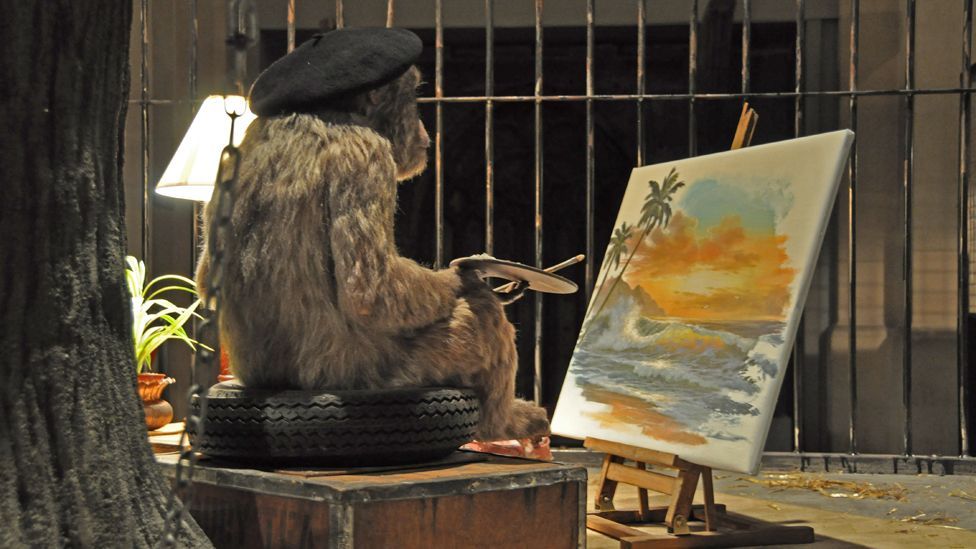
A few animals are prodigious producers of 'art', says Jason G Goldman. Why do they do it? Do they enjoy the artistic process? And is their work whatsoever good?
A
At offset glance, the Vogelkop Gardener bowerbird is pretty boring. Its drab olive-brown feather makes information technology difficult to spot against the dirt on which information technology lives. However, a closer expect reveals that this otherwise dull bird has a surreptitious: the males build some of the well-nigh elaborate, aesthetically-pleasing objects of whatsoever bird.
Bowers are decorated structures that the males build to woo females. In some places they're tall towers made of sticks resting upon a round mat of expressionless blackness moss, busy with snail shells, acorns, and stones. In other places, they're woven towers built upon a platform of green moss, adorned with fruits, flowers, and severed butterfly wings. Private Vogelkop bowerbirds accept their ain tastes, preferring certain colours to others. The males place each item in their bowers with slap-up precision; if the objects are moved, the birds render them to the original arrangement.
"Decorating decisions are non automatic merely involved trials and 'changes of mind,'" wrote UCLA physiologist Jared Diamond, 1 of the first researchers to intensively study the birds' complex bowers. Diamond discovered that bower building was non innate, at least not entirely. The younger birds had to learn how to build the all-time bowers, either through trial and error, or past watching more experienced birds, or both.
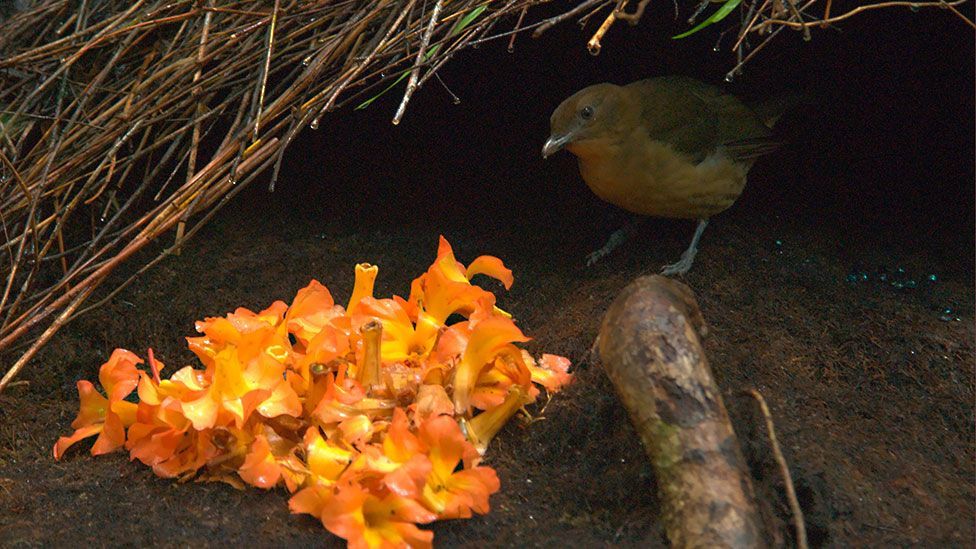
A Vogelkop bowerbird inspects his creation (Nature Picture Library/Alamy)
Diamond concluded that bower building was a culturally transmitted artistic process where each bird had his or her ain individual tastes and preferences, and where each determination was made with intention and care. Bowerbirds, in other words, are brute artists – at least in sense that they have intendance in producing unique works that humans and birds alike find aesthetically pleasing.
Bowerbirds aren't the just non-human artists. Congo was a male person chimpanzee born in 1954 at London Zoo. When Congo was two years old, the British zoologist and artist Desmond Morris gave the chimp a pencil. "He took it and I placed a piece of card in forepart of him," Morris told The Telegraph in 2005. "Something strange was coming out of the end of the pencil. Information technology was Congo's beginning line. It wandered a short way and and then stopped. Would it happen again? Yes, information technology did, and again and again." Congo eventually graduated from pencils to paintbrushes. He and his art were featured on the British television programme Zoo Time, and in 1957 the Plant of Contemporary Arts featured his piece of work in an exhibition.
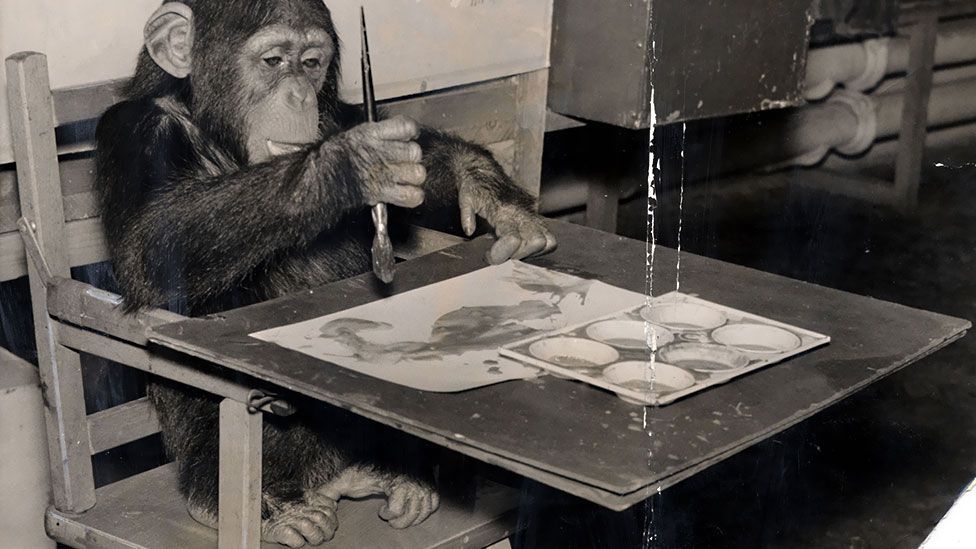
Congo the chimpanzee at London Zoo in 1957 (Daily Mail /REX)
While he never painted identifiable images – no portraits, no landscapes, no nonetheless lifes – Congo'due south fashion was unironically described by some equally "lyrical abstract impressionism". He seemed to have a sense of intention in his paintings, and a sense of coherence. If his paintings or brushes were taken away earlier he felt he was washed, he whined until they were returned to him. If he had completed his work, he refused to go along painting fifty-fifty at Morris's prompting.
In 2005, a set of three paintings past Congo, who created more than than 400 works in his lifetime, were sold at auction for £14,400. In the same auction, an Andy Warhol painting and a Renoir sculpture went unsold.
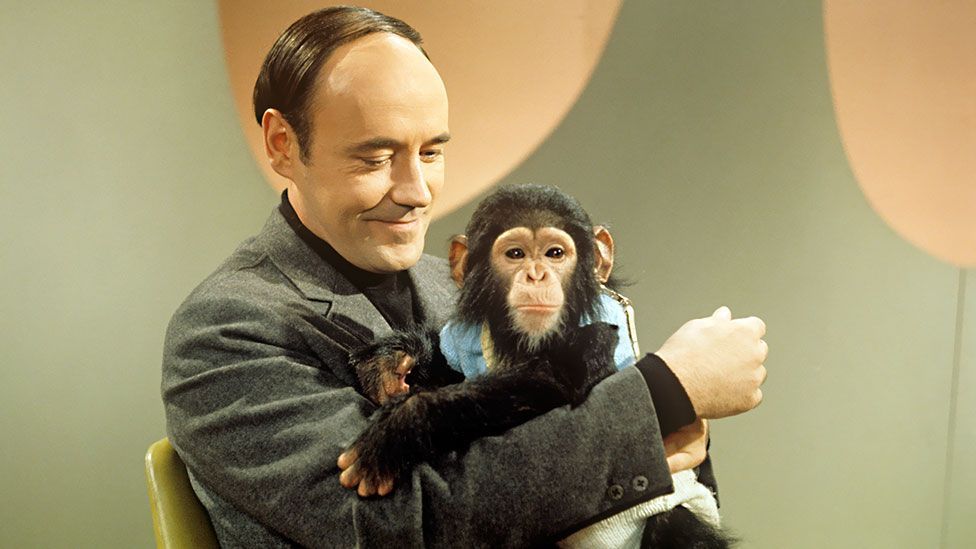
Desmond Morris and Congo (BBC)
Congo may have once been a zoological marvel, a rare primate who was given the unique opportunity to express his artistic desires – or at to the lowest degree to smear graphite and paint onto a apartment surface. But in the decades since he produced his showtime drawing, zoos have been giving paintbrushes to animals as a common do. The hope is that these attempts at creative expression help keep animals happy.
While putting paintbrush to canvas isn't past any means a natural activity for a chimpanzee, elephant, or any other non-human beast, it is thought to help innovate some novelty into the lives of those animals. Painting is an activeness through which the animals tin exercise their minds, instead of just their bodies – "enriching" the otherwise deadening captive environment. The idea is to stop the animals reverting to repetitive, compulsive behaviours. But does it work?
The jury is still out, and the benefits of creating art equally mental exercise probably varies quite a bit from individual to individual. Just at least i scientific study has been conducted on painting in zoo elephants, and the results are disappointing for brute art advocates.
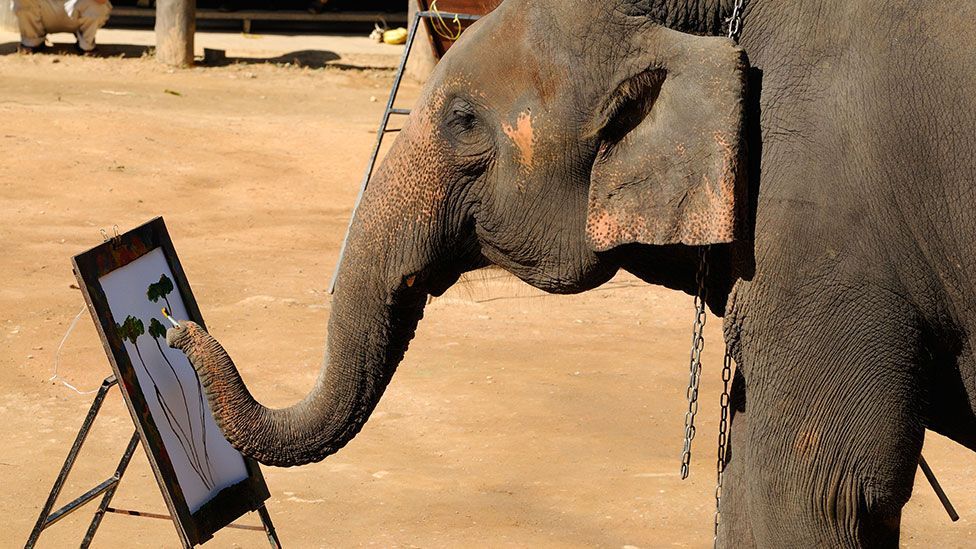
Elephant painting in Chiang Mai, Thailand, controlled by its keeper holding its ear (Amar and Isabelle Guillen/Guillen Photo LLC/Alamy)
The researchers focused on four Asian elephants at the Melbourne Zoo. They found that painting didn't reduce stress-related behaviours in the elephants, nor did information technology decrease repetitive or abnormal behaviours either before or after their painting sessions.
What that means, according to the researchers, is that painting "does not improve the welfare of elephants". Given that, they suggest "its master benefit is the aesthetic appeal of these paintings to the public and their subsequent sale of which a percentage of funds might exist donated toward conservation of the species". Only since the report was limited to just four individuals, it is difficult to derive wider conclusions.

This video is no longer available
Watch animal artists in action (UCL Grant Museum of Zoology/Rob Hawkeye)
Whether drawing or painting serves whatsoever useful purpose at the zoo, it is at least clear that humans are not the only animals capable of creating works of art, nor are we the only ones who announced to derive satisfaction from information technology.
Still, the simple deed of transferring pigment to canvass isn't by itself necessarily an expression of creativity for animals, any more than than it is for our species. The question of what constitutes art, of what qualifies as creativity, is something that human being culture has grappled with for generations. After all, on appearances alone, some might lump Jackson Pollock's work together with Congo's; that could either reflect tremendous respect for the work of the chimpanzee, or contempt for abstruse expressionism. Or maybe some will never appreciate animal art. One study in 2011 establish that people were surprisingly proficient at spotting the difference betwixt professional art and works done by chimps and elephants, and they preferred the human being paintings.
Then is animal art whatsoever practiced? That depends on your individual perspective.
If you would like to annotate on this, or anything else y'all have seen on Time to come, head over to our Facebook or Google+ folio, or message us on Twitter .
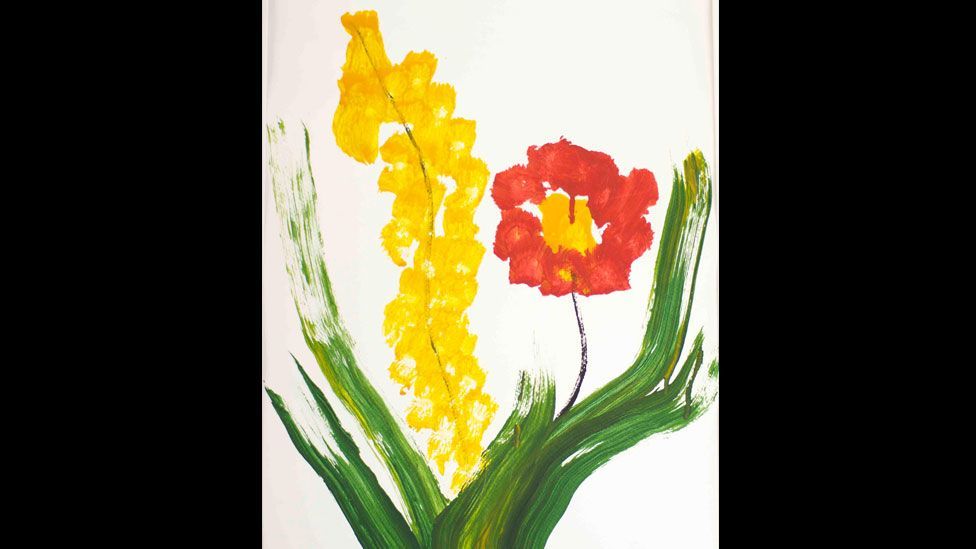
We're non the just creatures to produce fine art. Can you guess which animals did these paintings? Answers at the end. (UCL Grant Museum of Zoology/Rob Hawkeye/CC BY-NC 2.0)
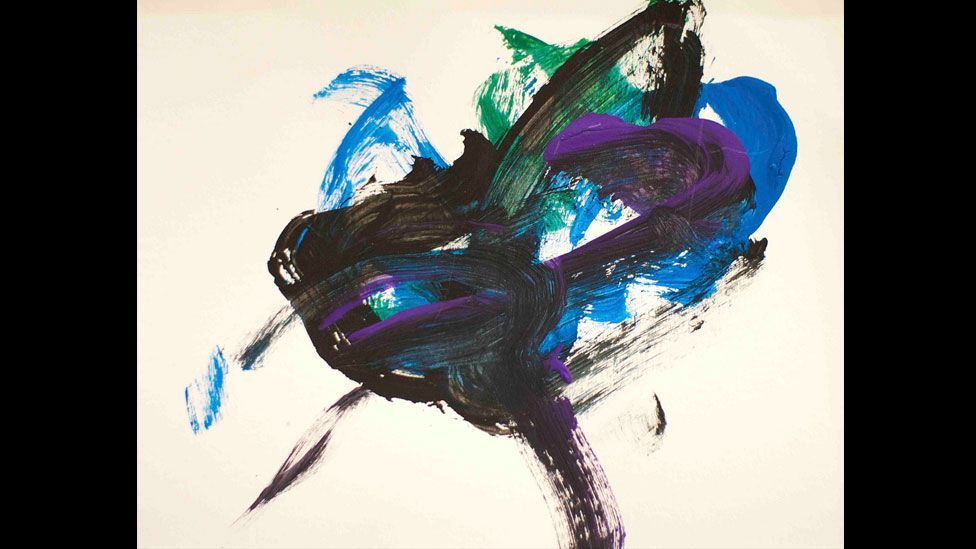
Untitled by an animal artist called 'Baka', based in Colorado. (UCL Grant Museum of Zoology/Rob Eagle/CC BY-NC 2.0)
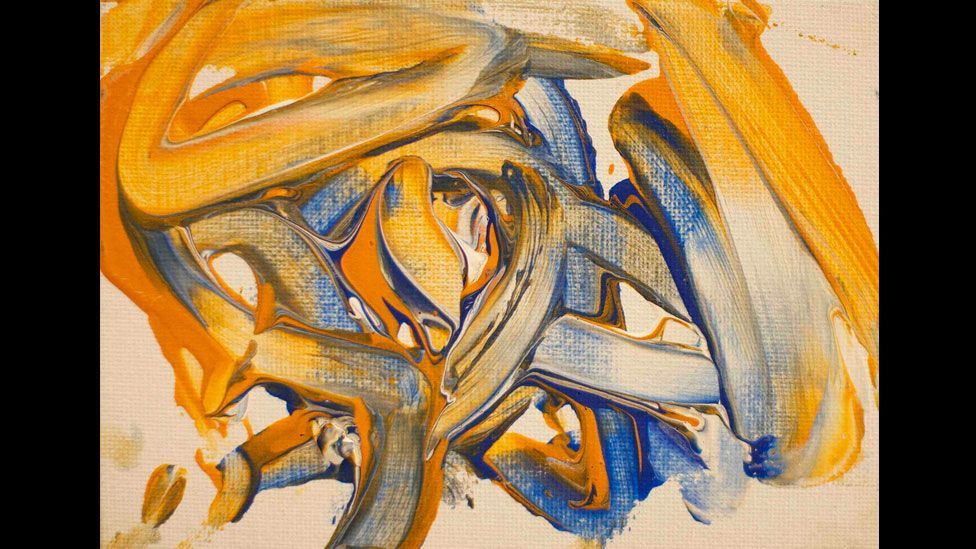
Digit Primary by the artist Bakhari, who lives in Missouri. (UCL Grant Museum of Zoology/Rob Hawkeye/CC By-NC 2.0)
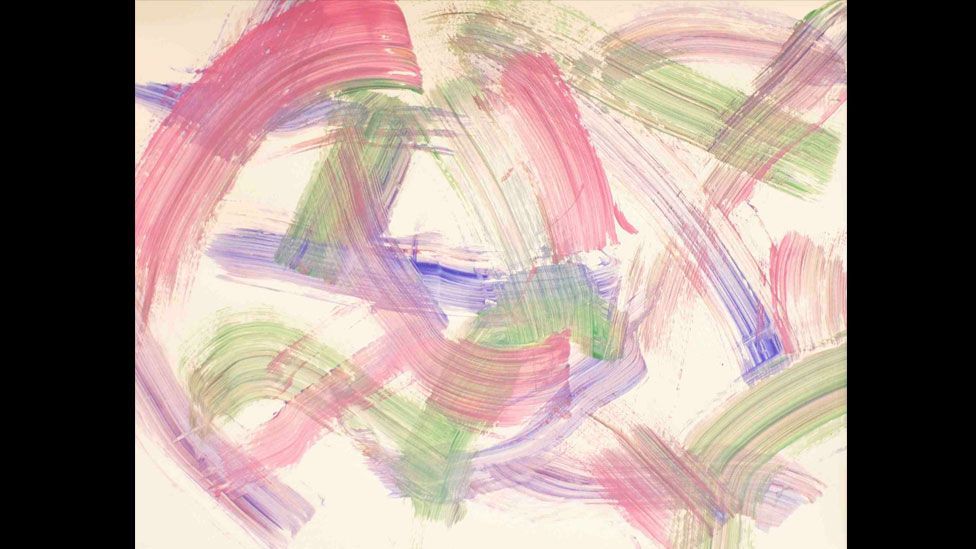
Untitled (2011) by Samantha, Pennsylvania. (UCL Grant Museum of Zoology/Rob Eagle/CC By-NC ii.0)
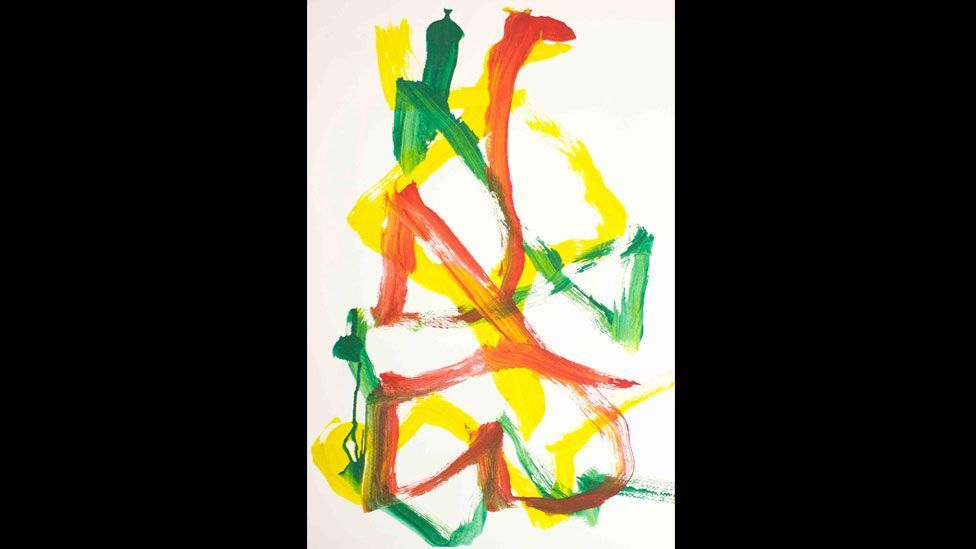
Abstract Painting (2010) by Nong Banking concern, Thailand. (UCL Grant Museum of Zoology/Rob Hawkeye/CC BY-NC 2.0)
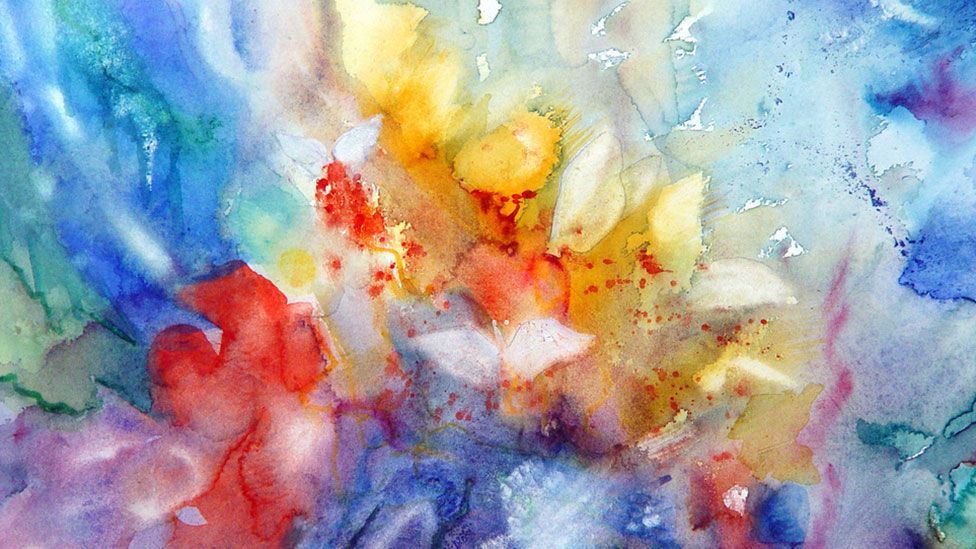
A watercolour by Nadia. (Nadia Minic/Flickr/Art: watercolour 2009:...calorie-free of a dream...or promise for a new dearest…/CC BY-NC two.0)
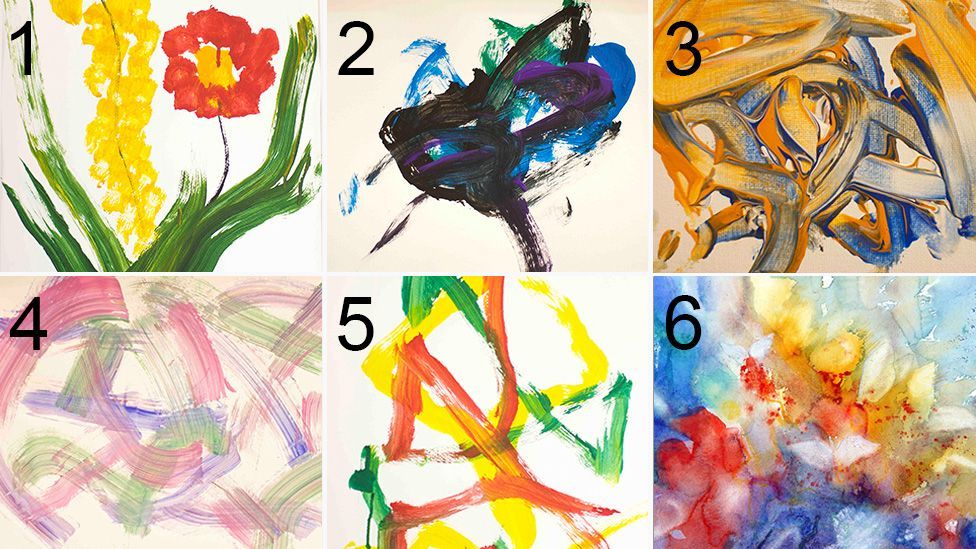
i. Elephant 2. Sumatran Orang-utan 3. Chimp 4. Gorilla 5. Elephant 6. Human being
Source: https://www.bbc.com/future/article/20140723-are-we-the-only-creative-species
0 Response to "O How Do Animals Reflect Human Nature Desirable andor Despicable in Art?"
Post a Comment